March is National Save Your Vision Month
 The American Optometric Association sets aside each March to raise awareness on something most of us take for granted – our vision. So much of our lives are governed by visual stimulation. All we have to do is open our eyes and we absorb so much information about surroundings from information to entertainment. Whether we can see sharply or in some diminished capacity we heavily rely on our visual frames of reference to govern our day to day decisions and activities!
The American Optometric Association sets aside each March to raise awareness on something most of us take for granted – our vision. So much of our lives are governed by visual stimulation. All we have to do is open our eyes and we absorb so much information about surroundings from information to entertainment. Whether we can see sharply or in some diminished capacity we heavily rely on our visual frames of reference to govern our day to day decisions and activities!
Today we have more threats to our eye health than ever. With all the electronics used in the workplace and at home now, the risk of eye strain is higher than ever before. March is National Save Your Vision Month. Let’s look at eye care in the workplace and at home and how we can protect this precious asset.
The Importance of Regular Check-ups
When was the last time you had your vision checked? If it has been more than two years then you need to pick up the phone and make an eye doctor appointment now. Usually visits are recommended every two years unless you are at risk for vision problems, then visits may need to be an annual activity. If you have high blood pressure, diabetes or a history of family vision problems then you will need to visit the eye doctor once a year to make sure you address any signs of vision problems as early as possible.
Many people believe if their general health is fine then their vision must be fine too. This may not be the situation. Gradual onset of a problem may not be evident as we have no way to really measure the changes to our eye health. Only eye doctors can detect early signs of diseases that when diagnosed early can be treated. If left undiagnosed and untreated irreversible damage can be done to your eyes and vision. These diseases can include:
- Glaucoma – where the nerve connecting the eye to the brain is damaged, usually due to high eye pressure
- Age-related macular degeneration – causes loss in the center of the field of vision
- Cataracts – cloudy film that covers part of the eye causing bluriness
- Diabetic retinopathy – damage to the blood vessels in the tissue at the back of the eye (retina)
Regular eye check-ups can help flag early problems that can be treated. Those check-ups can also help catch problems that might affect those in the workplace thus reducing work-related injuries and accidents. Needless to say everyone, whether working at home or in the business workplace, can benefit from regular checkups to ensure our eyes are in the best health possible!
Your Visit to the Eye Doctor
Be sure to bring any current eye glasses, contact lenses, sunglasses or eye prescriptions (if seeing a new eye doctor) to your next appointment. Make a list of questions or concerns to share with your eye doctor. You may also want to bring another person or sunglasses with you in case the eye doctor needs to dilate your pupils (puts drops in your eyes to measure nerve and retina activity), you develop temporary blurred vision and need to have someone drive you home.
What Tests Might the Eye Doctor Perform
 Eye muscle movement test: This checks your eyes’ alignment. The doctor will watch your eyes move while you follow a target (like a finger tip or his pen) as it moves in different directions.
Eye muscle movement test: This checks your eyes’ alignment. The doctor will watch your eyes move while you follow a target (like a finger tip or his pen) as it moves in different directions.- Cover test: This tells how well your eyes work together. You’ll stare at a small target some distance away. The doctor will cover and uncover each eye to observe how much your eyes move. Your doctor will also be watching for an eye that turns away from the target. This is a condition called strabismus. You may take the test again with a target close to you.
- External exam and pupil reactions: The doctor will watch how your pupils adjust to light and objects close to you. At the same time, the whites of your eyes and the position of your eyelids will also be checked.
- Visual acuity test: You’ll sit in front of an eye chart, with letters that get smaller as you read down each line. You’ll cover each eye in turn and, using the other eye, read aloud, going down the chart, until you can’t read the letters anymore.
- Refraction testing: For your exact lens prescription, the doctor can use a computerized refractor. Your doctor may fine-tune the prescription by flipping the phoropter back and forth between lenses and asking you which is better. If you don’t need corrective lenses, you won’t have this test.
- Slit lamp (biomicroscope): This device magnifies and lights up the front of your eye. The doctor uses it to check your cornea, iris, lens, and the back of your eye, looking for signs of certain eye conditions.
- Retinal examination ( ophthalmoscopy ): Your doctor may dilate your pupils and use a tool called an ophthalmoscope and to see the back of your eyes — the retina, retinal blood vessels, fluid in your eyes (he may call this vitreous fluid), and the head of your optic nerve.
- Glaucoma testing: This procedure checks to see if the fluid pressure inside your eyes is within a normal range. It’s fast, painless, and can be done in a couple of ways:
- Tonometer: This is the most accurate. You’ll get drops to numb your eyes. The doctor will tell you to stare straight ahead and will barely touch the front surface of each eye with a tool called an applanation tonometer or Tonopen to measure the pressure.
- Puff of air or noncontact tonometer: You’ll stare at a target, and a machine will let out a small puff of air into each eye. How much your eye resists the puff indicates the pressure inside it.
- Pachymetry: This test uses ultrasound to measure the thickness of your cornea. Thin corneas can lead to false low-pressure readings. Thick corneas can lead to false high-pressure readings. You’ll get this test just once to create a baseline for comparison with future readings. It can be used for people who need corneal surgery.
- Pupil dilation (enlargement): With your pupils fully enlarged, the doctor will use tools and lights to check the insides of your eyes. The eye drops for this part of the exam take about 20-30 minutes to work. They make your eyes more sensitive to light and blur your vision. These effects may last for several hours or longer. This is why you might need those sunglasses on your way home. Newer machine can look in the far back of your retina without your pupils being dilated.
- Visual field test (perimetry): Your visual field is the area you can see in front of you without moving your eyes. Using one of three tests, the eye doctor maps what you see at the edges (periphery) of your visual field and will use this map to diagnose eye conditions. (1)
Digital Eye Strain
Your eye doctor may also ask you during your visit about your exposure and daily use of electronic equipment, which includes computers, laptops, tablets, smartphones, television, video games, etc. Regular and prolonged use of one or more of these electronic devices can cause digital eye strain. This condition occurs when your eyes become fatigued from straining to look at these devices throughout the day. You may experience headaches, fatigue, burning or dry eyes, blurry or double vision, and neck and/or back strain.
Digital eye strain can cause productivity problems in the workplace or even working at home. Learn to recognize the signs of digital eye strain and give your eyes a break. The blue light emitting from these digital screens combined with small digital print can cause serious, but not dangerous, eye strain.
To help avoid unnecessary eye strain follow the 20-20-20 rule: every 20 minutes, look away from the screen for 20 seconds and look at something 20 feet away. This will allow your eyes to relax and refocus.

Other things you can do to help your eye health include placing your monitors at least an arm’s length away with the middle of screen just below your normal line of sight. Keep your monitors out of direct sunlight and keep the glare on the screen at a minimum to reduce the strain on your eyes. Put the monitor directly in front of you so you don’t have to turn or strain your neck or head to read the screen. (This also applies to your television and other electronic devices you use to read information.)
For those concerned about digital eye strain in the workplace you can consult your local Human Resource department or your state Occupational Safety and Health Administration (OSHA) division to learn more about ergonomics in the workplace. They provide training, assessments, guidance and monitoring on situations where good ergonomics should be implemented to avoid workplace injuries. This includes working with computers on your desk, in a lab, on a manufacturing floor, out in the field or anywhere else where time is spent working on screens. Don’t hesitate to get (usually free) assistance in optimizing your environment for work and learning how to take care of your body, including your eye health!
Harmful Blue Light
 Many people believe the blue light emitted from screens can be harmful to their eyes, especially when reading at night in the dark. My family is guilty of this one. We like to read our smartphones or laptops at night in bed in the (near) dark before we go to bed.
Many people believe the blue light emitted from screens can be harmful to their eyes, especially when reading at night in the dark. My family is guilty of this one. We like to read our smartphones or laptops at night in bed in the (near) dark before we go to bed.
Well the blue light emitted from these devices are not actually harmful to the eyes but to the brain. The blue light suppresses the production of melatonin, which is what your body needs to fall asleep. Instead blue wavelengths suppress delta brainwaves, which induce sleep, and boost alpha wavelengths, which create alertness. So keeping rooms beyond a dim light and reading blue lit screen devices just before bed will actually cause you problems trying to sleep. While you’re trying to convince yourself to go to sleep all the damage from blue light is telling your body to stay awake.
How to fix this problem. Ideally you should not use any computers, laptops, tablets, smartphones, television, or other blue light emitting screens 30 to 60 minutes before bed. This will allow time for melatonin production to take place naturally and for your body to ready itself for sleep.
However, if you have to watch that late night news, catch up on email or social media or get those last minute “to dos” written in your task listing then there are things you can do to help block those blue light waves. Wear blue light blocking glasses such as the ones below (I need to get a pair too!):
 |
 |
 |
| Blue Light Blocking Glasses | Blue Light Blocking Glasses that fit over regular glasses |
Blue Light Blocking Glasses with Magnification Options |
The blue light blocking glasses work great for daytime use if you sit in front of computer or television screens a good portion of the day.
There are also options for putting a special screen protector on your electronic devices to help filter out blue light emissions. There are also apps you can download to your smartphone that switch your light to “natural color” when the room is too dark or when you want to read or play on the phone within that 60 minutes of that advised window for melatonin production. There is an app for Android phones and iPhones users can enable the “Night Shift” mode, which Apple says is automatically enabled on their 5 series and above. Here are instructions in case you need to enable it manually. (My daughter has an iPhone and she says this mode helps her fall asleep right after she puts the phone down for the night.) Here is a link to enabling the blue light filter on Microsoft Windows 10 computers and laptops.
March is National Save Your Vision Month Conclusion
The bottom line is you only have one set of “peepers” and you need to take good care of them. This means getting in to see the eye doctor at least once every two years or once per year if you have high blood pressure, diabetes or a history of family vision problems. It is important to catch eye conditions and diseases as soon as possible so preventive action can be taken to reduce further degeneration. If you suspect problems earlier than your next appointment talk to your eye doctor right away. You rely on your eyes to process so much information around you that you need to keep them working in tip top shape for as long as possible. Make an appointment today if it has been longer than two years since you last had your “peepers” checked!
To your improved health…and sight!
References:
(1) WebMD – How Often Should I Get My Eyes Checked?
